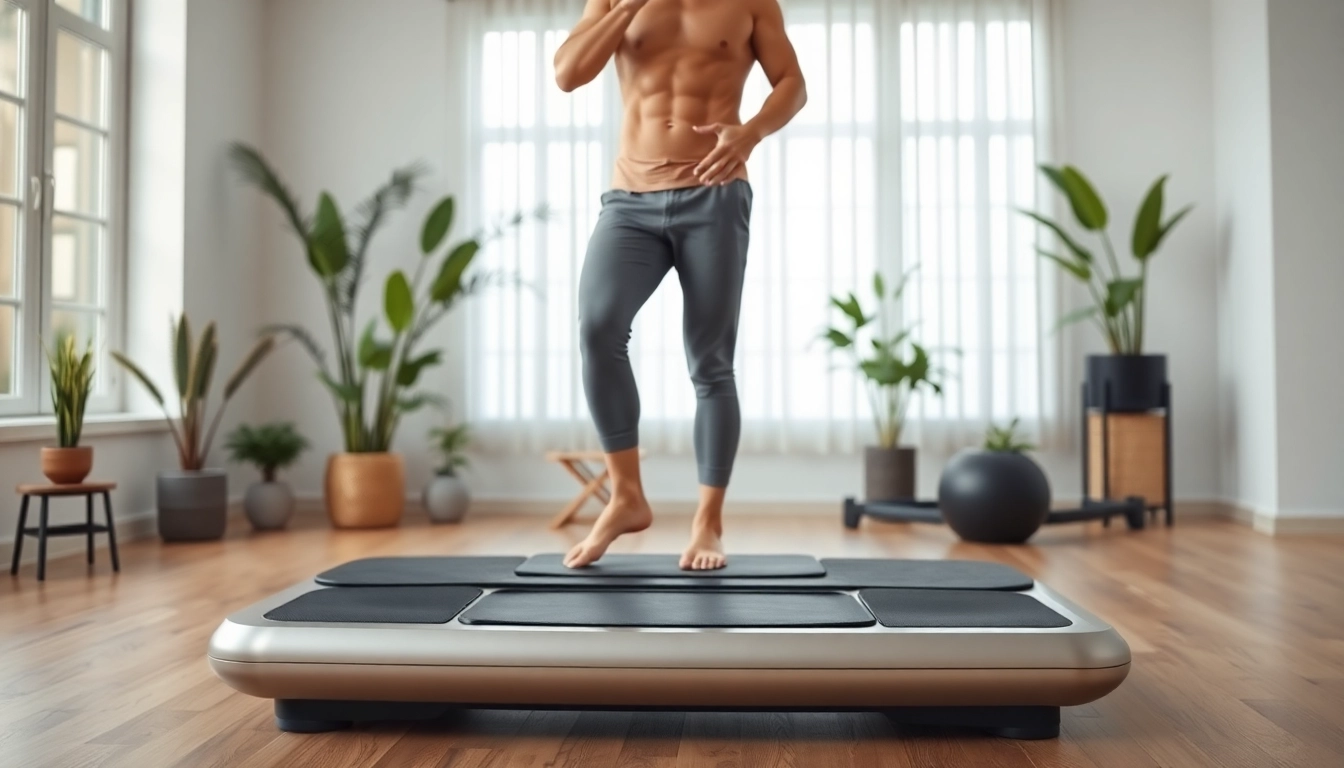Understanding Whole Body Vibration Therapy
What is Whole Body Vibration Therapy?
Whole body vibration therapy (WBV) is an innovative therapeutic approach that utilizes vibrating platforms to stimulate the body’s muscles through mechanical vibrations. In essence, patients either stand, sit, or lie on a machine equipped with a vibrating surface while the platform oscillates at varying frequencies. This unique method propagates energy throughout the body, leading to rapid muscle contractions and relaxations. The outcome is often described as a passive form of exercise, as it compels the body to engage multiple muscle groups without any significant physical effort. Many individuals across various demographics are exploring the potential benefits of whole body vibration therapy to enhance their overall health and well-being.
How Does Whole Body Vibration Therapy Work?
The mechanics of whole body vibration therapy revolve around the physics of vibrations and their application to the human body. When a person stands on a vibrating platform, the vibrations provoke involuntary muscle contractions. Studies show that these contractions can occur up to 30 times per second, which significantly increases muscle activity and energy expenditure. As the muscles contract, various systems in the body respond positively, such as improved neuromuscular performance, enhanced circulation, and increased flexibility.
The therapy can enhance proprioception—the body’s ability to sense its position in space—leading to better balance and coordination. Furthermore, it stimulates the release of growth hormone and other beneficial biochemicals that contribute to overall well-being. By integrating different movement patterns—such as standing still, squatting, or performing light exercises while on the platform—users can customize their experiences for desired outcomes.
History and Development of Whole Body Vibration Therapy
Whole body vibration therapy has its roots in research dating back to the 1960s, originally utilized by the Russian space program to maintain astronauts’ muscle mass and bone density during extended periods in microgravity. Over the years, the technology has evolved, and various studies have investigated its potential benefits. As the popularity of fitness technologies surged, whole body vibration therapy transitioned into mainstream wellness and rehabilitation practices.
By the 1990s, it garnered attention in the Western Hemisphere, and equipment designed for personal and clinical use began to flood the market. Today, whole body vibration therapy is employed in diverse settings ranging from physical therapy clinics to fitness centers and even home gyms, appealing to various demographics, including athletes, the elderly, and individuals with mobility impairments.
Physical Benefits of Whole Body Vibration Therapy
Enhancing Muscle Strength and Tone with Whole Body Vibration Therapy
One of the most prominent benefits of whole body vibration therapy is the enhancement of muscle strength and tone. Research indicates that WBV can increase muscle strength and power output in both young and elderly subjects. The muscle contractions stimulated by the vibrations mimic resistance training without physical strain, making it an appealing alternative for those unable to engage in traditional weight lifting due to injury or limitations.
Clinical studies highlight improvements in lower body strength following regular sessions of WBV, particularly in athletes undergoing training. Moreover, dual-training protocols that combine vibration therapy with conventional strength exercises have resulted in accelerated strength gains, demonstrating the synergistic effects of vibration training.
Improving Circulation and Blood Flow
Whole body vibration therapy promotes enhanced circulation and blood flow, projecting positive implications for cardiovascular health. As the platform vibrates, it facilitates the dilation of blood vessels, leading to a boost in blood circulation throughout the body. Improved blood flow ensures that oxygen and nutrients are efficiently delivered to tissues, accelerating recovery rates and promoting overall wellness.
Individuals with conditions such as chronic venous insufficiency may benefit significantly from enhanced circulation, potentially reducing symptoms associated with poor blood flow. Furthermore, enhanced circulation plays a role in flushing out toxins from the body, contributing to overall detoxification.
Impact on Weight Management through Whole Body Vibration Therapy
Weight management is a pressing concern for many individuals, and whole body vibration therapy may provide a valuable tool in this endeavor. Through the muscle contractions induced by WBV, users burn calories without the associated fatigue of traditional forms of exercise. Studies have shown that incorporating WBV into a weight management program can lead to measurable reductions in body fat and improvements in body composition.
Although WBV should not be considered a standalone solution, its incorporation alongside a balanced diet and regular exercise has yielded positive results for individuals looking to lose weight. Additionally, the therapy can improve metabolic rates, which may aid in maintaining weight loss and supporting long-term health.
Mental and Emotional Benefits
Reducing Stress and Anxiety with Whole Body Vibration Therapy
Beyond physical benefits, whole body vibration therapy has been linked to mental and emotional well-being. The therapy has been shown to prompt the release of endorphins, chemicals in the brain that function to alleviate pain and induce feelings of euphoria. This response can contribute to reduced stress and anxiety levels, offering users a sense of relaxation and improved mood.
With the fast pace of modern life contributing to escalating stress levels, many individuals are seeking effective ways to unwind. By integrating whole body vibration therapy into a wellness routine, users can harness its potential to foster relaxation and create a haven from daily stresses.
Boosting Mood and Cognitive Function
Research indicates that whole body vibration therapy may enhance cognitive function and boost overall mood. The increased blood flow and circulation resulting from vibrations support brain health by providing vital oxygen and nutrients necessary for optimal cognitive performance. Users report heightened focus and alertness following therapy sessions.
Furthermore, the mind-body connection cultivated through vibration therapy promotes mindfulness and mental clarity, equipping individuals with useful tools for managing daily challenges. As such, WBV can serve as a complementary modality to traditional mental health interventions.
Whole Body Vibration Therapy and Mental Health
The implications of whole body vibration therapy for mental health are increasingly being explored. Emerging studies have begun to draw connections between WBV and improvements in conditions such as depression and anxiety, showing promise as a supportive therapy alongside conventional treatments.
Regular exposure to whole body vibration may stimulate positive neuroplasticity—the process by which the brain reorganizes itself, forming new neural connections. This neurobiological aspect underpins potential improvements in emotional regulation and mental resilience, positioning WBV as a valuable component in holistic mental health approaches.
Practical Applications of Whole Body Vibration Therapy
Incorporating Whole Body Vibration Therapy into Fitness Regimens
Whole body vibration therapy can serve as a robust addition to fitness regimens, catering to individuals seeking comprehensive workouts without undue strain. Fitness enthusiasts can integrate WBV sessions as part of their warm-up or cool-down routines for enhanced performance. It can also be utilized to target specific muscle groups while performing bodyweight exercises such as squats or lunges on the vibrating platform.
Gym instructors and personal trainers can employ WBV to personalize fitness plans, offering modifications for clients with physical limitations. Incorporating this therapy into group classes can make sessions more engaging and enjoyable, setting the stage for collaborative fitness journeys.
Whole Body Vibration Therapy for Rehabilitation
Rehabilitation settings have embraced whole body vibration therapy as a valuable adjunct modality for various recovery protocols. Medical practitioners may utilize WBV for patients recovering from surgery, injury, or illness by providing gentle stimulation that promotes healing and rehabilitation.
Individuals with compromised mobility or strength can benefit significantly from WBV, as it allows controlled engagement of muscle groups without mechanical stress. In a therapeutic context, it serves to reinforce neural pathways and improve functional mobility, ultimately enhancing the quality of life for patients across various age groups and diagnoses.
Home Use vs. Professional Sessions of Whole Body Vibration Therapy
Advancements in technology have made it increasingly accessible to utilize whole body vibration therapy in both professional settings and at home. For individuals seeking convenience, home-use machines can provide a cost-effective solution for regular sessions. However, professional settings often offer access to high-quality machines with additional features and expert guidance that may be beneficial for beginners.
Those new to vibration therapy might consider introductory sessions in a clinical or fitness environment to gain familiarity before investing in home equipment. Evaluating personal goals, safety preferences, and budget constraints can help in making an informed decision tailored to individual needs.
Safety and Considerations
Potential Risks Associated with Whole Body Vibration Therapy
While whole body vibration therapy is generally regarded as safe for many individuals, there are potential risks and side effects to consider. Users may experience mild headaches, fatigue, or muscle soreness after sessions, particularly if they are new to the modality or engage in intensive programs.
Listening to one’s body and gradually acclimating to the vibrations is crucial. Those who feel unwell or exhibit unusual symptoms should cease use and consult a healthcare provider. A tailored approach that considers individual fitness levels and health status is vital for mitigating risks.
Contraindications for Whole Body Vibration Therapy
Several contraindications exist where whole body vibration therapy should be approached with caution or avoided altogether. Individuals with cardiovascular conditions, joint problems, or recent surgeries should consult a physician before engaging in WBV. Furthermore, those with a history of seizures or neurological conditions must exercise extreme caution.
Pregnant women and individuals with severe osteoporosis or bone fractures should refrain from using WBV. By acknowledging personal health circumstances and consulting healthcare professionals, users can approach whole body vibration therapy safely.
Best Practices for Safe Use of Whole Body Vibration Therapy
To maximize the benefits of whole body vibration therapy while minimizing risks, incorporating best practices is essential. Initially, users should start with shorter sessions, around 5-10 minutes, gradually increasing duration as they become accustomed to the vibrations.
Adhering to manufacturer guidelines for machine use and maintenance will ensure safety and efficacy. It is advisable to perform WBV while maintaining a stable posture, focusing on core engagement to prevent discomfort. Ultimately, integrating whole body vibration therapy with proper warm-ups, cool-downs, and hydration creates an effective and safe routine for users.



